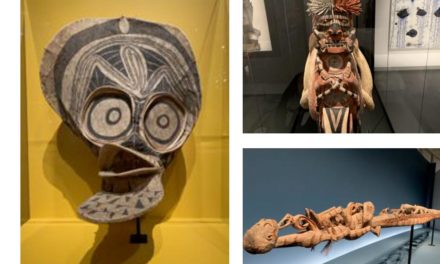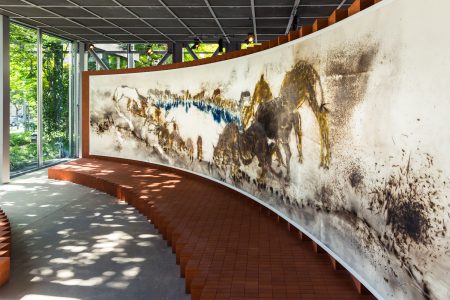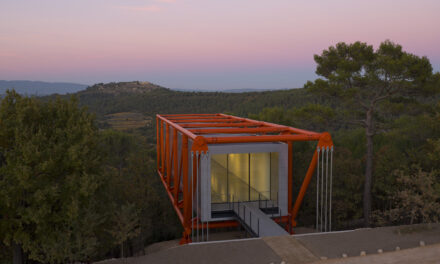Brancusi’s studio
At a time when the Centre Pompidou is organising a retrospective of the great sculptor of the first part of the twentieth century, Constantin Brancusi, just after closing the artist’s studio for good, we might recall that another great sculptor, the American Richard Serra, who passed away on 26 March 2024 had the revelation of his vocation precisely by visiting Brancusi’s studio.
Pneumonia
He died of pneumonia at the age of 85. For several years he had been suffering from cancer of the lacrimal duct in his left eye, which immobilised him in his home in New York State, according to the New York Times.
Bilbao’s Serpent
Richard Serra is the inventor of a monumental sculpture that, to be appreciated, has to be walked on, as in his permanent installation at the Guggenheim Bilbao, “Serpent”, designed between 1994 and 1997. Each of the four parts that make up the sculpture is 15 metres long. It weighs 180 tonnes.
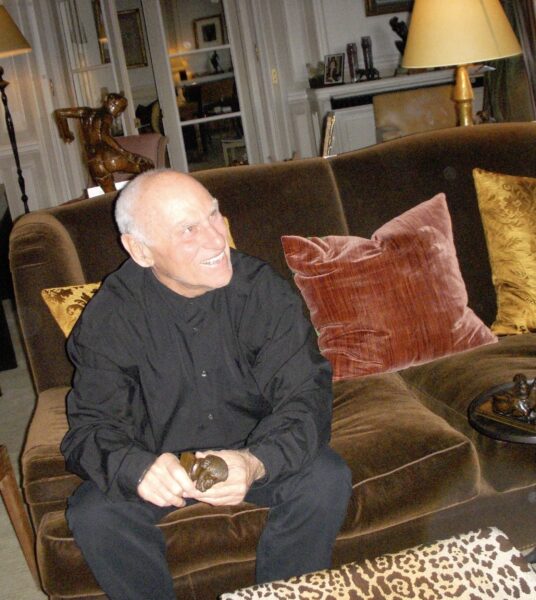
Richard Serra in 2008 in Paris
Promenade at the Grand Palais
In Paris in 2008, as part of the Monumenta programme, he occupied the nave of the Grand Palais with a work he titled “Promenade”. The man with the deep blue eyes designed a kind of cathedral made of five metal planks that seemed to have been thrown through the glass roof and planted in the ground. The inclination of the planks had been calculated to ensure their stability, as they were not deeply anchored in the concrete. As usual with Serra, this was a technical feat. Over the 13,500 m2 of the nave, each slab, placed 28 metres from the other, was 17 metres high and weighed 75 tonnes.
Redesigning the space of the Grand Palais
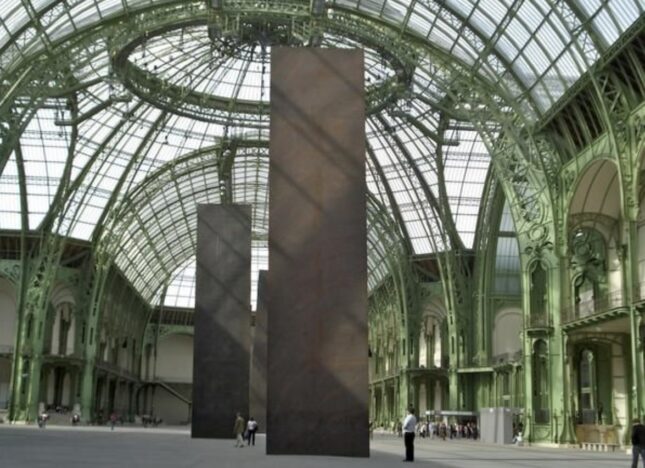
Yet they gave the illusion of lightness. Richard Serra’s objective, as he told us, was to “redesign the space of the Grand Palais. The plaques appear or disappear depending on where you are. On one side they seem to be placed in parallel, on the other in a triangle”. He added: “Ultimately, the experience is for the visitor. The interaction it has with your perception. From Mantegna’s Christ to Cézanne’s apples, it’s clear that the forms suggest weight, space and volume.
Serra/Seurat drawings
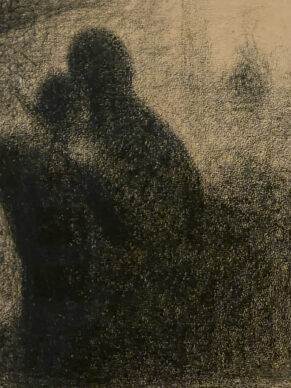
Georges Seurat (collection of Richard Serra)
Richard Serra, as iconoclastic as he seemed, was a man steeped in art history. This great fan of Georges Seurat owned three drawings by the post-Impressionist painter, with whom he lived every day. I co-curated a show dedicated to a dialogue between Richard Serra and Georges Seurat drawings in 2022 at the Guggenheim Bilbao (See the report here). As for three-dimensional works, he spontaneously referred to the monumentality of architecture.
Architecture
“There’s Sainte-Sophie in Istanbul. Do you know the impression you get in the chapel at Ronchamp designed by Le Corbusier? It’s very small but the space seems immense,” he explained. I don’t like the idea of narrative in sculpture. Isn’t it absurd to represent a horse in bronze and say that it’s reality? When you come here to the Grand Palais, you don’t need to know anything. The piece doesn’t refer to anything you already know. All you have to do is walk around. And experience it. No meaning: the meaning of the work is its effect on you.
Shipyard
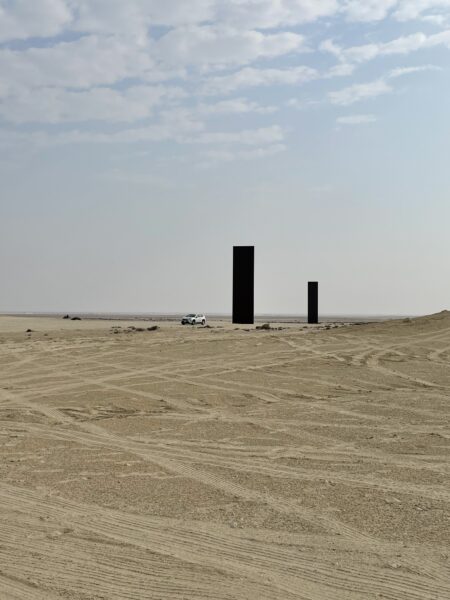
East West:West East Richard Serra
Richard Serra was born in San Francisco in 1938 to an immigrant father from Mallorca, a welder in the city’s shipyard during the Second World War, and a Jewish immigrant mother from Odessa. He would later recount how, at the age of four, his father took him to watch the launch of a super tanker. It was a decisive experience for the rest of his life. His career as an artist began with highly conceptual works. Between 1968 and 1979 he produced a number of videos before turning to metal plates.
East West/West East
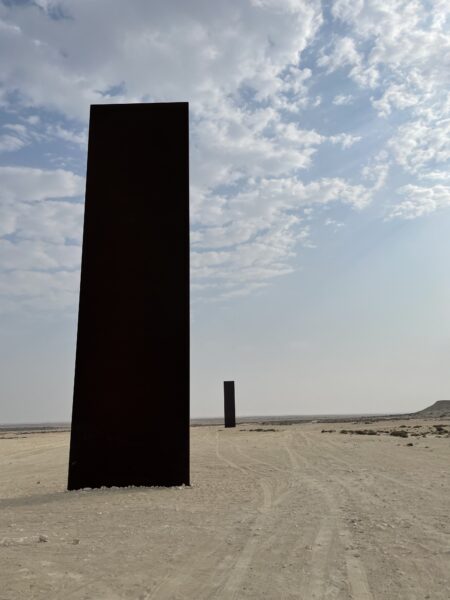
East West:West East Richard Serra
His last major work, East West/West East, was installed in the Brouq nature reserve in Qatar in 2014. The group of gigantic minimal sculptures set in the middle of the desert was organised in such a way that different perspectives could be glimpsed. It should be remembered that one of Richard Serra’s key works, Clara Clara (1983), which belongs to the French administration, is still housed in a warehouse in Paris. This was a source of annoyance for the artist, who used to say:
“I’m only interested in one thing in life: my work.
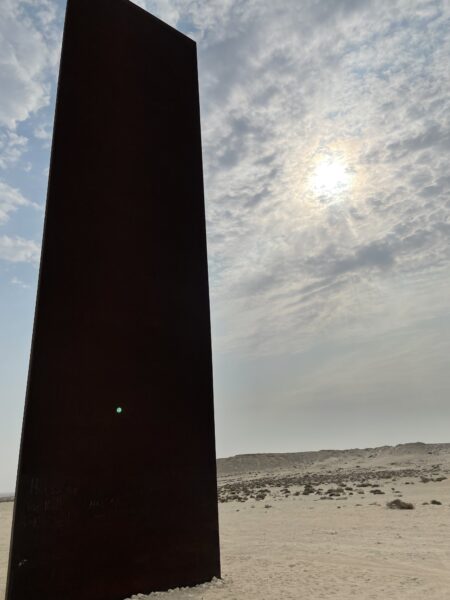
East West:West East Richard Serra
Donating=Supporting

Support independent news on art.
Your contribution : Make a monthly commitment to support JB Reports or a one off contribution as and when you feel like it. Choose the option that suits you best.
Need to cancel a recurring donation? Please go here.
The donation is considered to be a subscription for a fee set by the donor and for a duration also set by the donor.

